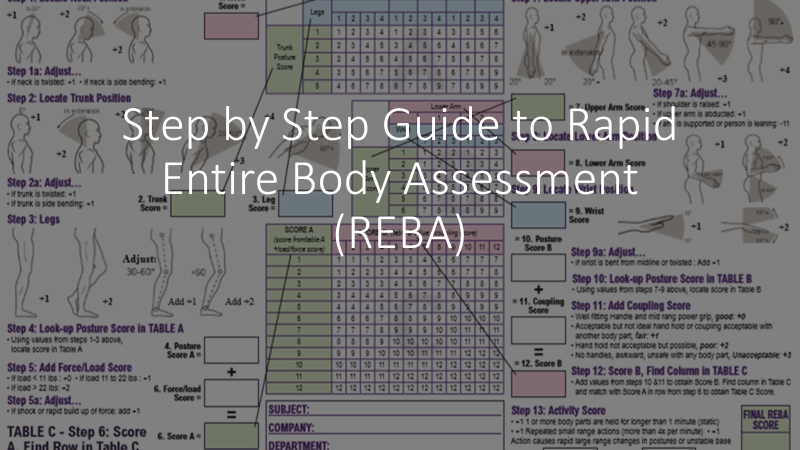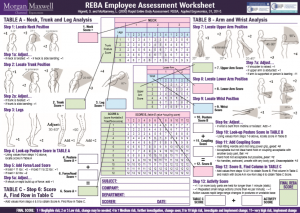

Rapid Entire Body Assessment (REBA) A Step by Step Guide with Free Worksheet PDF Download.
by Stephen Bowden, Chartered Ergonomist for Morgan Maxwell
This Rapid Entire Body Assessment (REBA) Worksheet Tool Guide will teach you how to use the REBA tool. The REBA tool was developed to identify high risk postures within the whole body. The guide provides a step by step guide with free PDF download.
Background to Rapid Entire Body Assessment (REBA)
The Rapid Entire Body Assessment (REBA) (Hignett and McAtamney, 2000) was developed to assess whole body working postures. Data is collected about postures adopted, type of movement, repetition, forces used and coupling. A final REBA score is generated to give an indication of the level of risk and urgency with which action should be taken. REBA was developed off the back of Rapid Upper Limb Assessment (RULA) which was designed in 1993. As the names suggest REBA focuses on the entire body with RULA focusing on the upper limbs and neck.
- REBA is designed to be a rapid tool. Once you get used to the tool it can be completed very quickly.
- Can assess inanimate or animate loads which are being handled either frequently or infrequently.
- The final score is a relative score of risk not an absolute score of risk.
- REBA is intended to be part of a broader ergonomics survey.
- A REBA assessment requires little time to complete and the scores generated fit into an action list which indicates the level of intervention required.
- REBA is a screening tool that assesses biomechanical and postural loading on the whole body.
REBA’s useful scoring system allows you to take a snapshot of the highest risk posture adopted during the task. The scoring system is broken down into four actions levels with indications in as to the urgency of the investigation.
Score 1 = Negligible Risk
Score of 2-3 = Low Risk. Change may be needed.
Score of 4-7 = Medium Risk. Further Investigation and Implement Change Soon.
Score of 8-10 = High Risk. Investigate and Implement Change.
Score of 11+ = Very High Risk. Implement Change.
REBA has six steps:
1.Observe the the task.
The assessor should, first of all, look to combine interview and observation techniques to build a rich picture of the task being assessed. Observe several cycles (ideally while filming) of the task while asking the person completing the task to speak aloud any concerns they have. The assessor should ensure that the full cycle of the task is observed before selecting final postures for scoring.
2. Select the postures for assessment.
From the data collected during interview and observation, the assessor can then select which postures to assess using the REBA tool. You should look to assess postures that are:
- Held for the longest period of time.
- Appears to be highest risk posture adopted.
- Posture associated with highest load.
- Most frequently repeated posture.
- Posture that requires the highest level of muscle activity.
- Posture that is know to cause discomfort from interviews and observation process in step 1.
- Awkward, unstable and extreme posture especially where high force is required.
3. Score the postures.
Using the Morgan Maxwell Rapid Entire Body Assessment (REBA) PDF Worksheet complete Table A (Neck, Legs & trunk Posture Score), Table B Lower Arm, Wrist and Upper Arm Score.
4. Process the scores.
Using the data collected form Table A and Table B you can establish the REBA score in Table C.
5. Establish the REBA score.
After the REBA Score has been established in table C the Activity Score needs to be established which is added to the final REBA score.
6. Confirm the action level with respect to the urgency for control measures.
The REBA Score is then checked against the action levels listed below.
Score 1 = Negligible Risk
Score of 2-3 = Low Risk. Change may be needed.
Score of 4-7 = Medium Risk. Further Investigation and Implement Change Soon.
Score of 8-10 = High Risk. Investigate and Implement Change.
Score of 11+ = Very High Risk. Implement Change.
If your organisation requires support from a Chartered Ergonomist or for support to complete an ergonomic workplace assessment please contact us.
Download you free REBA Infographic here – Rapid Entire Body Assessment (REBA) PDF Worksheet

